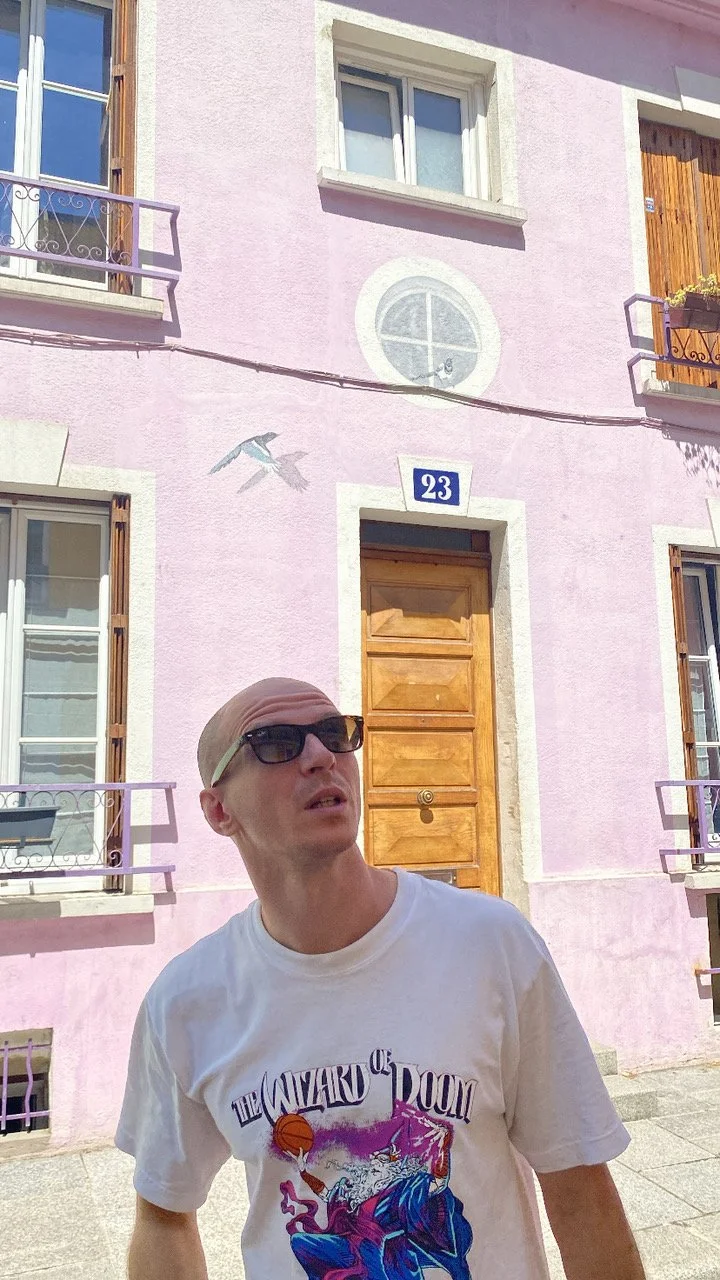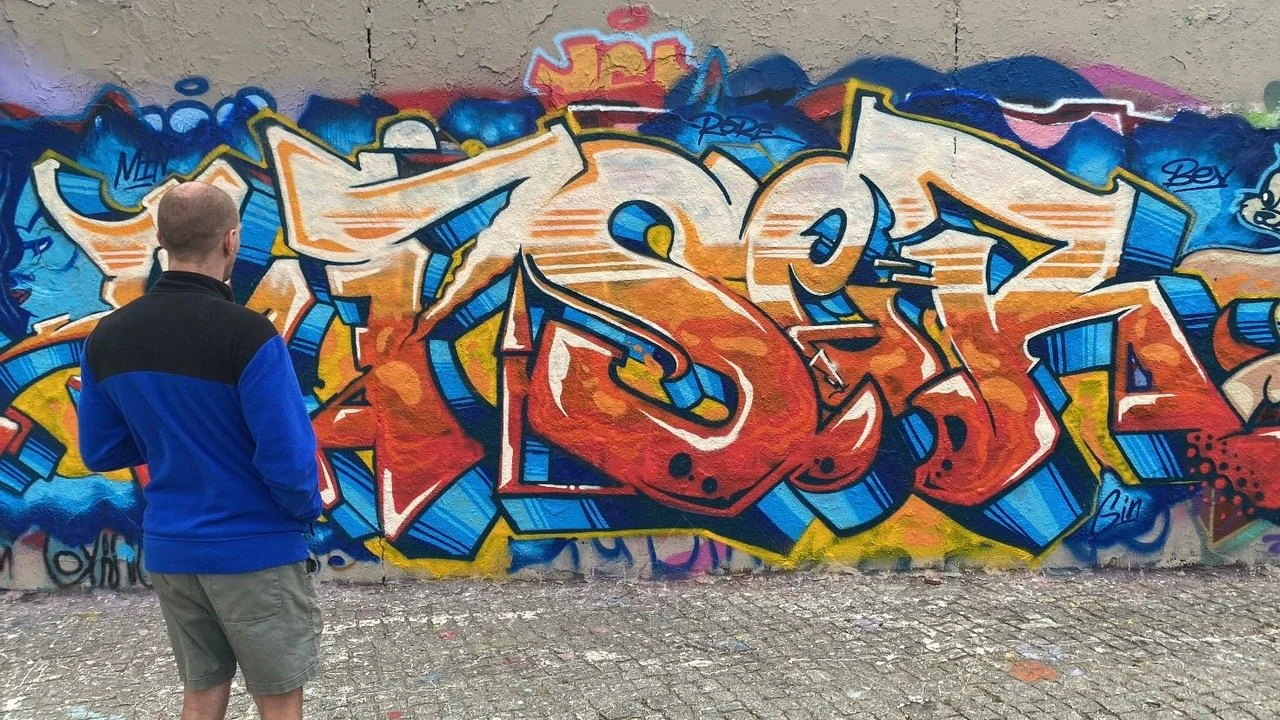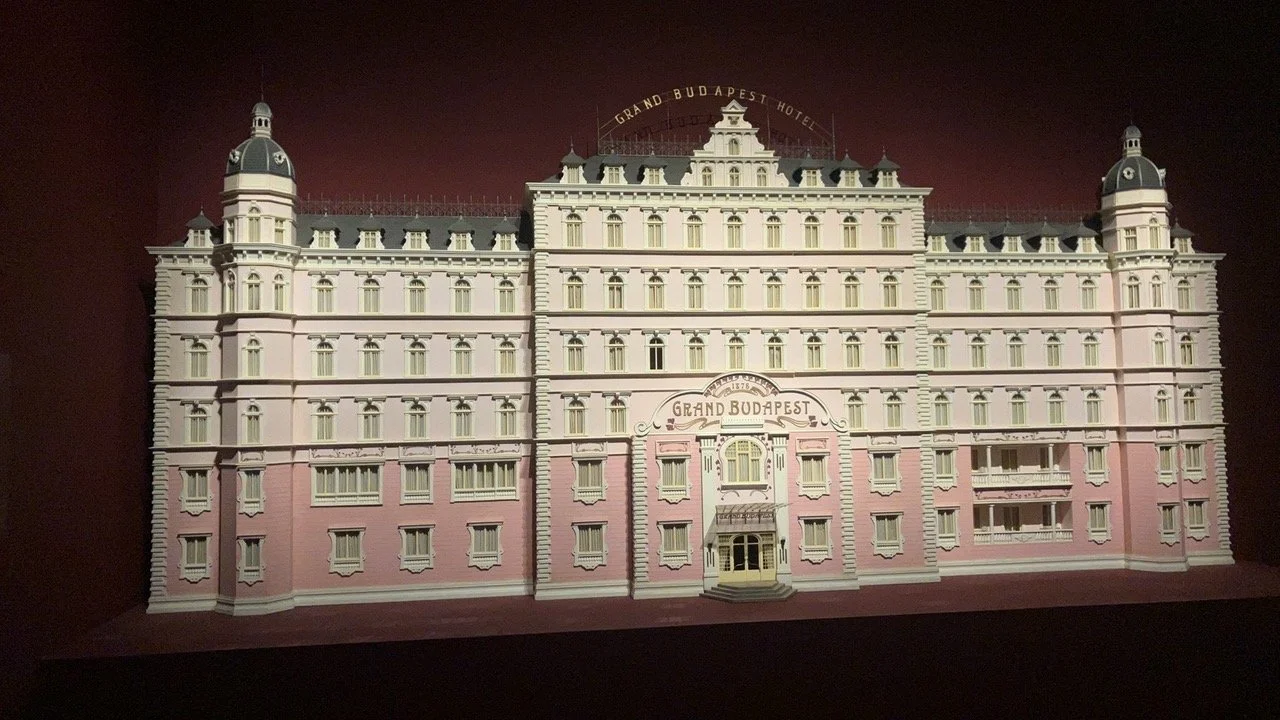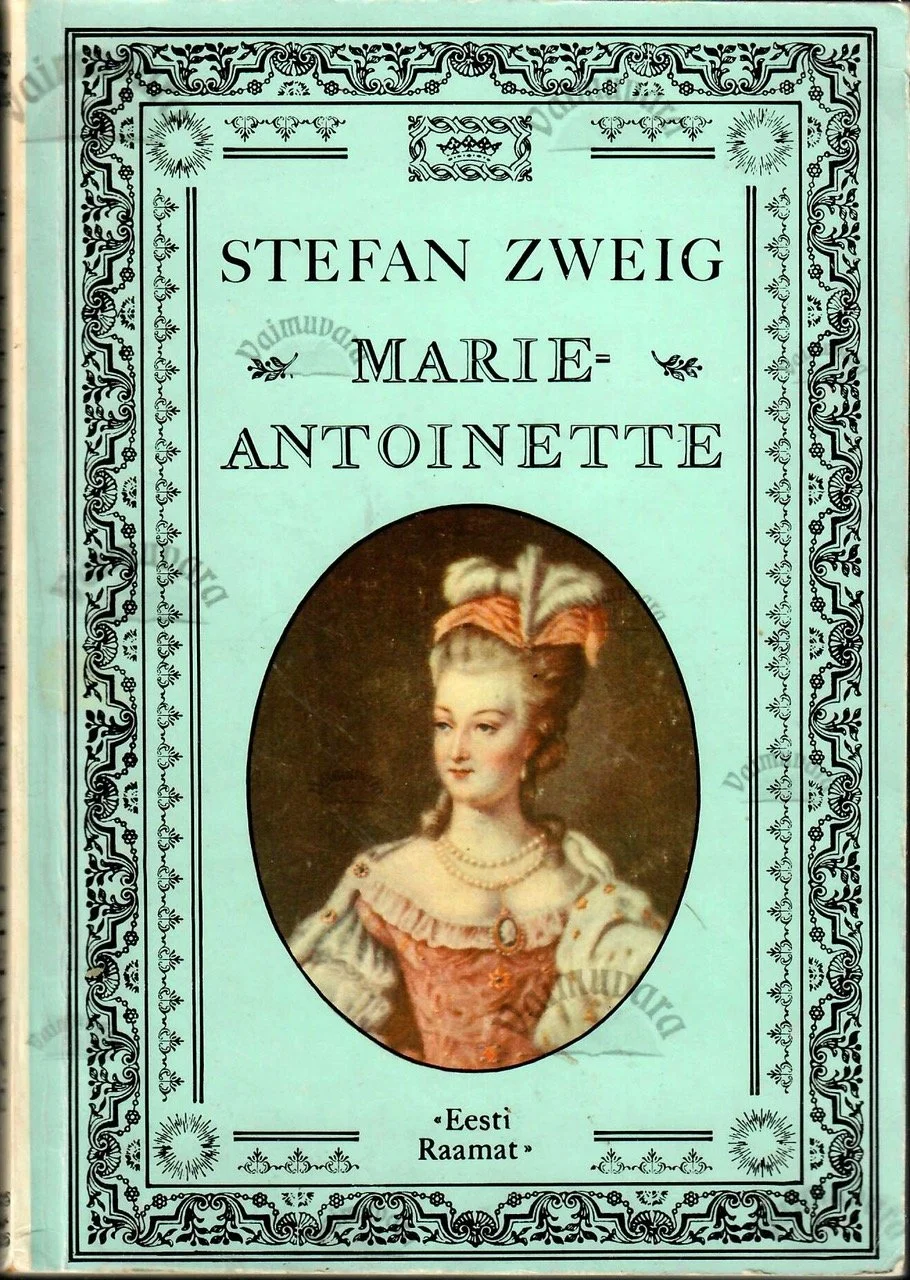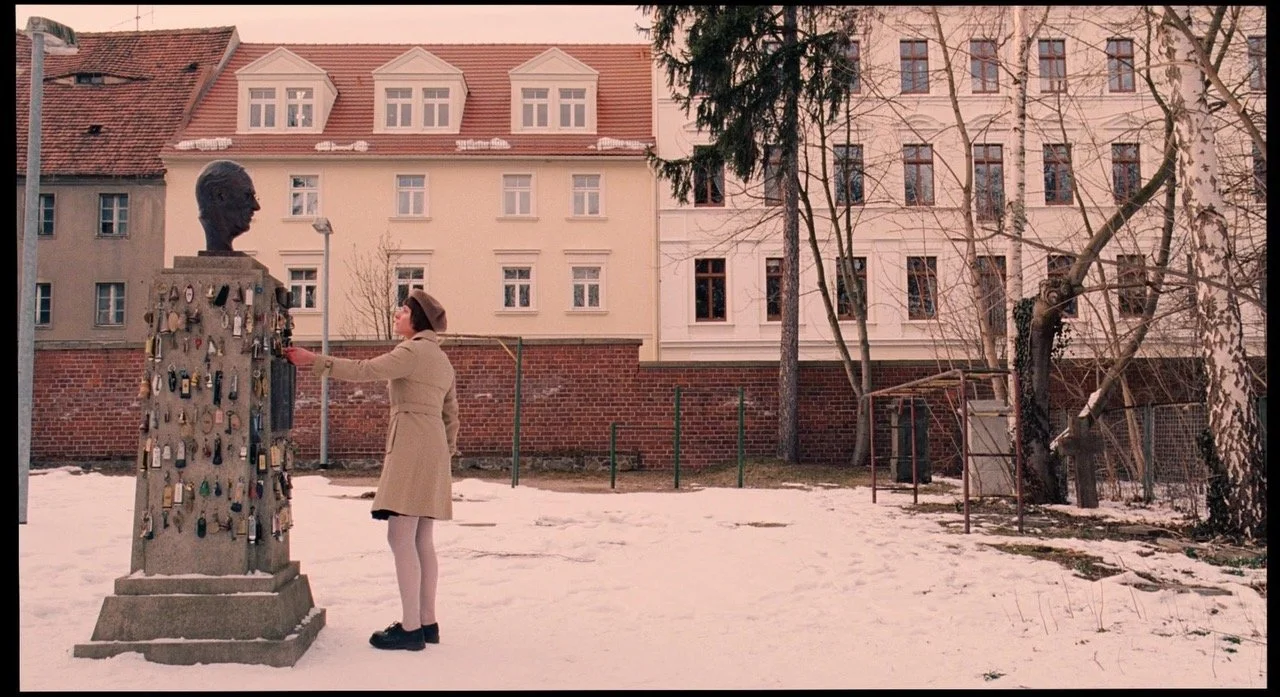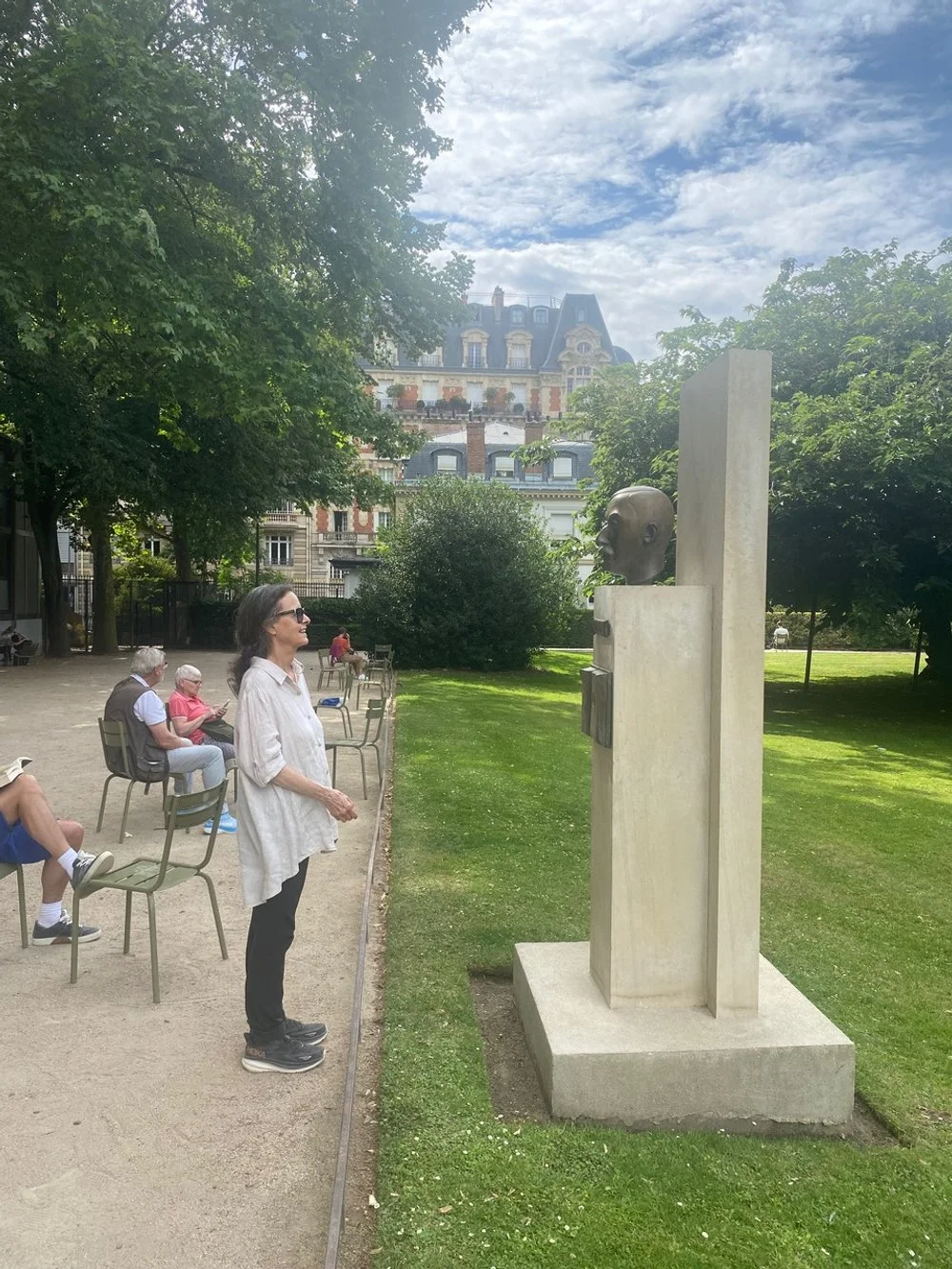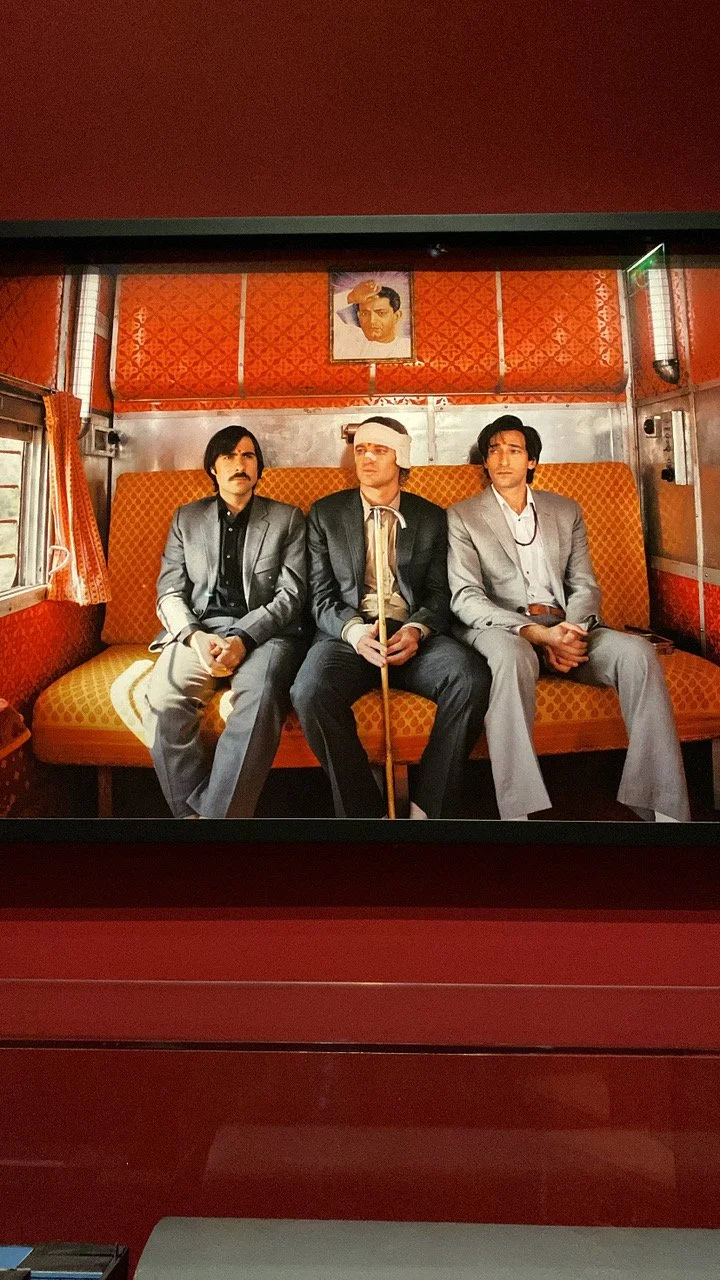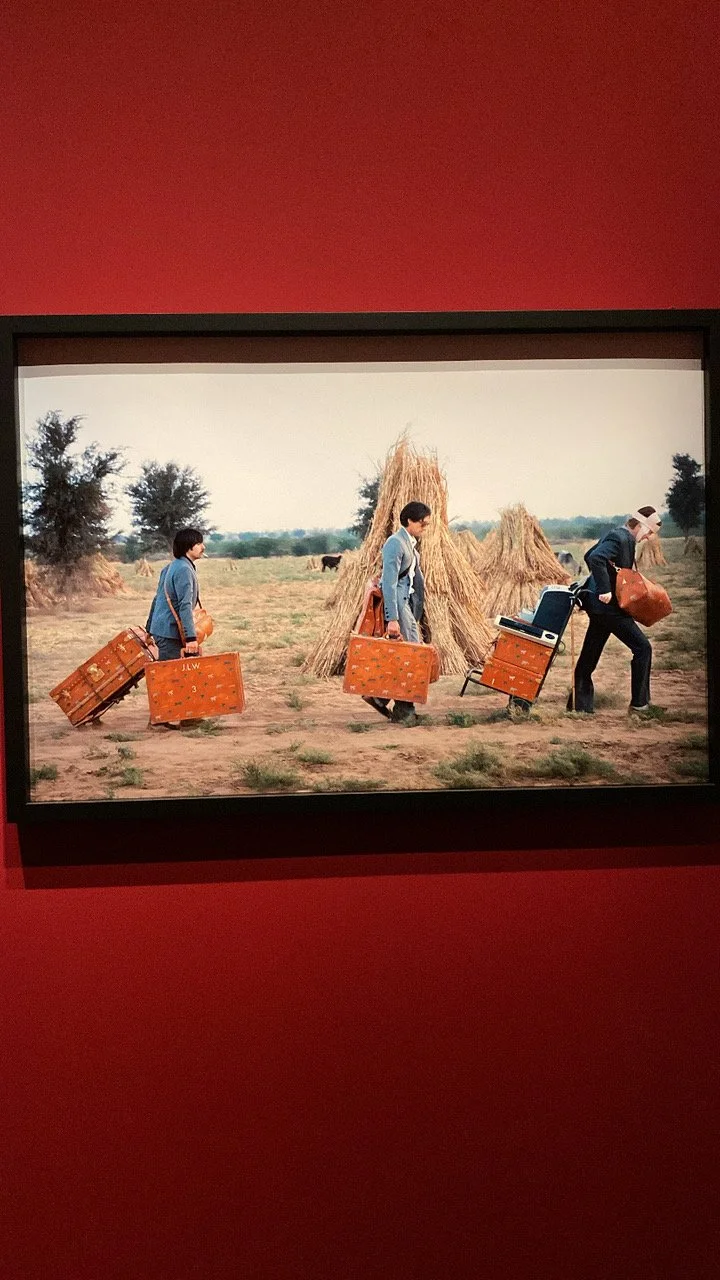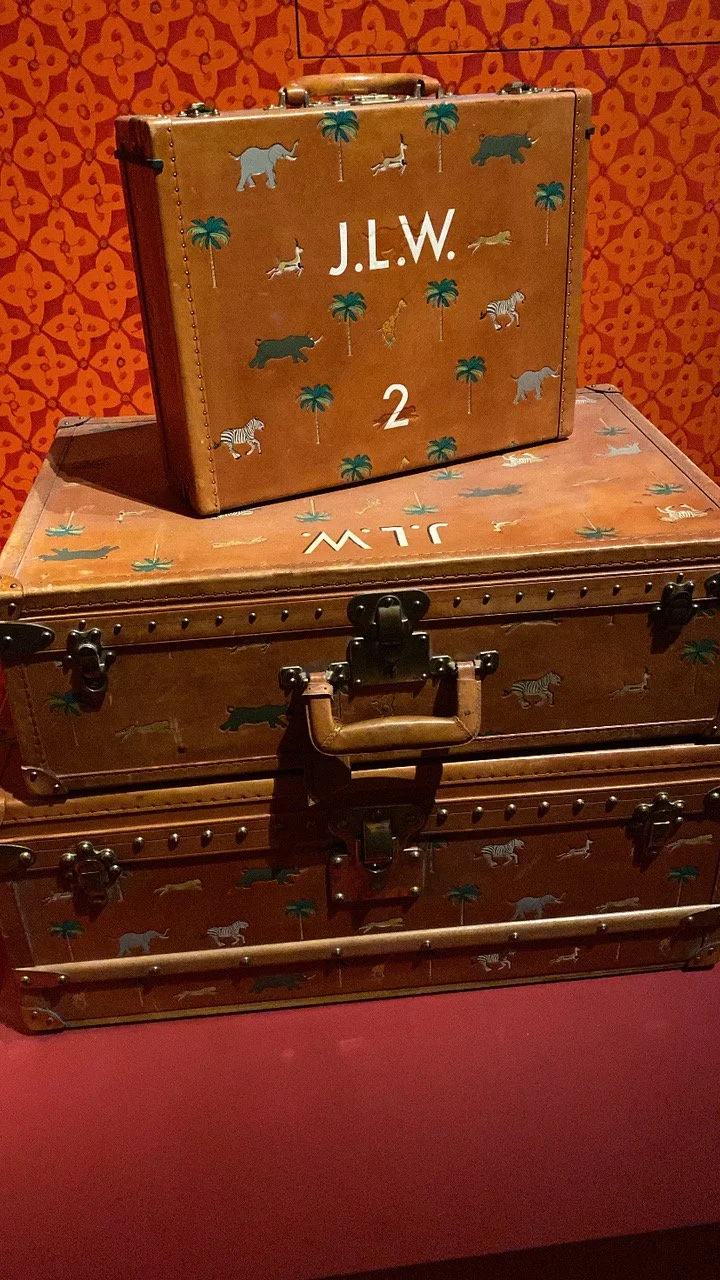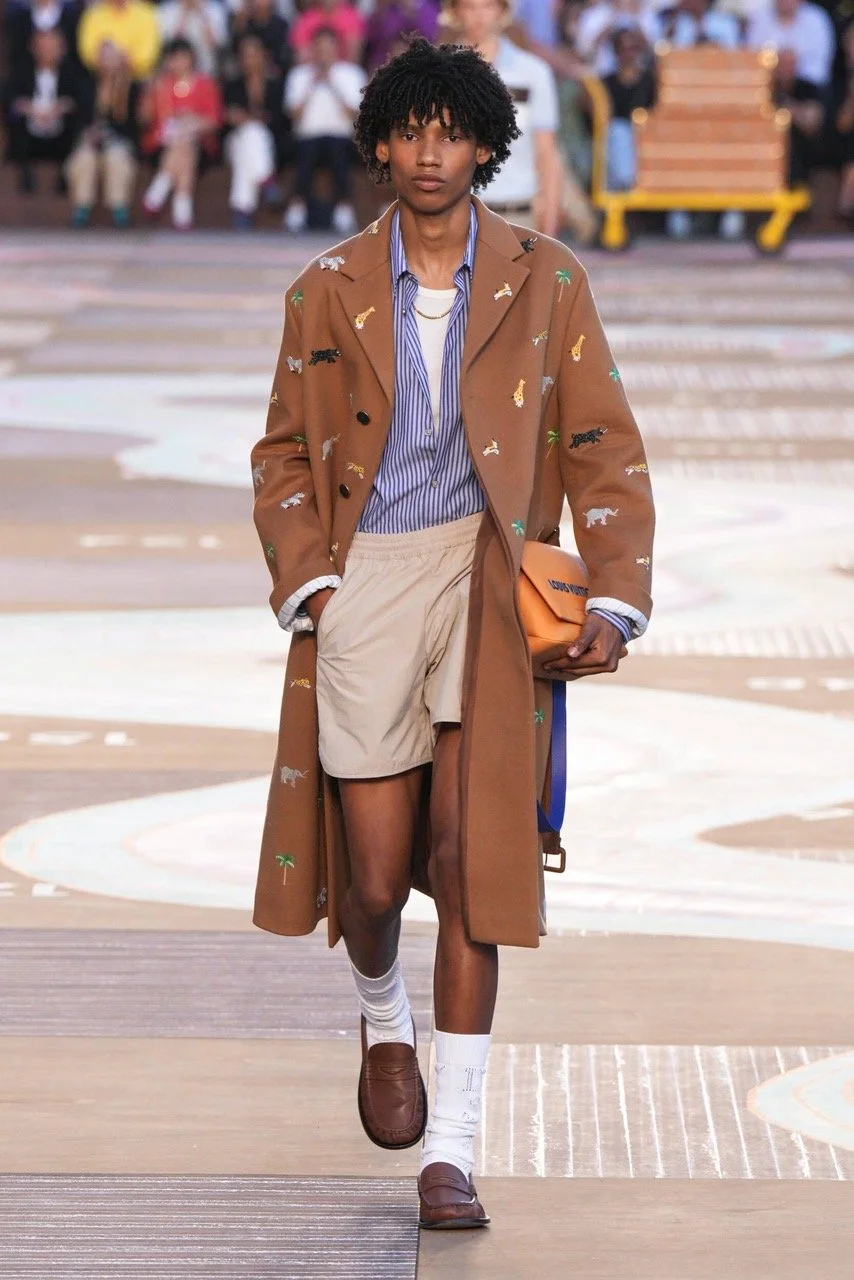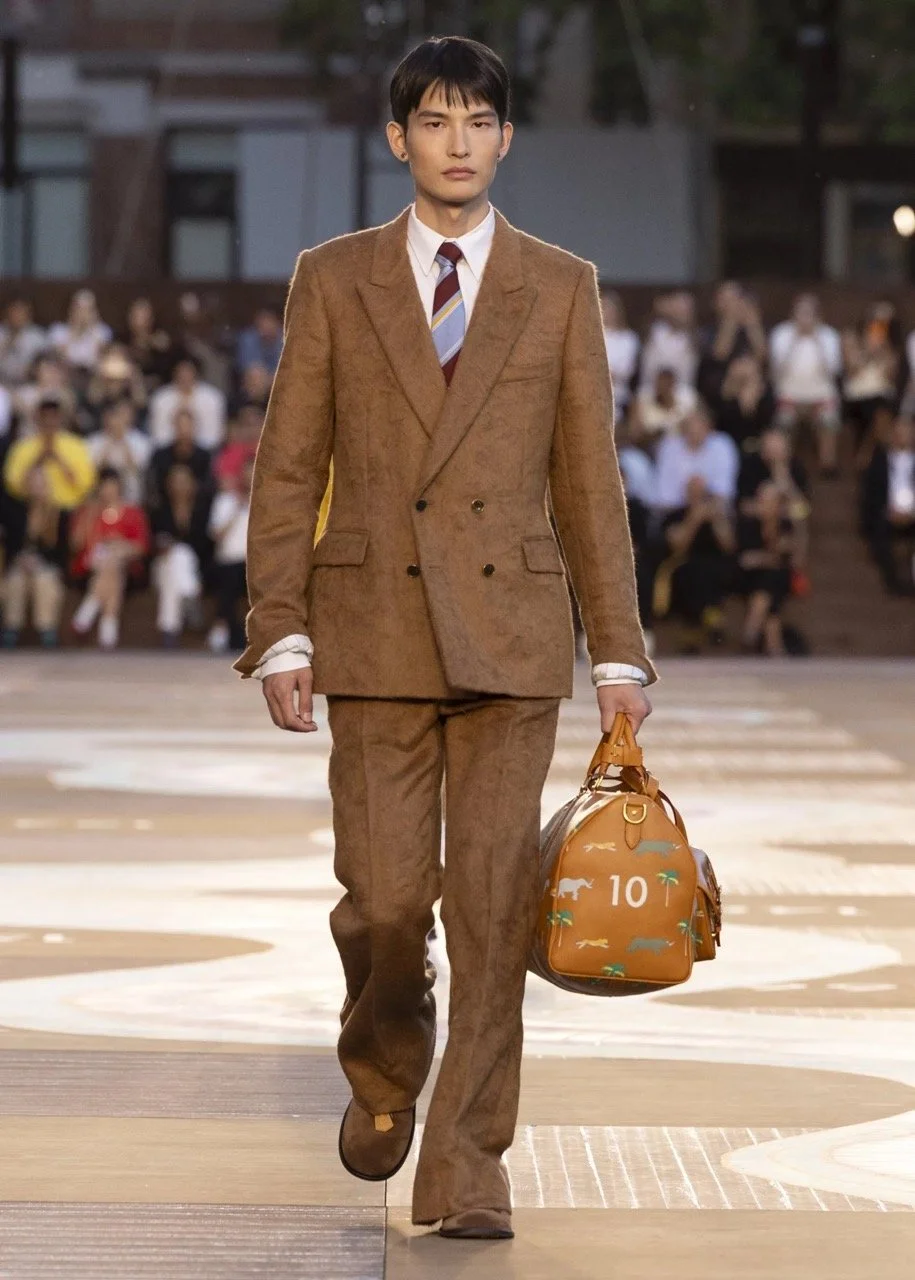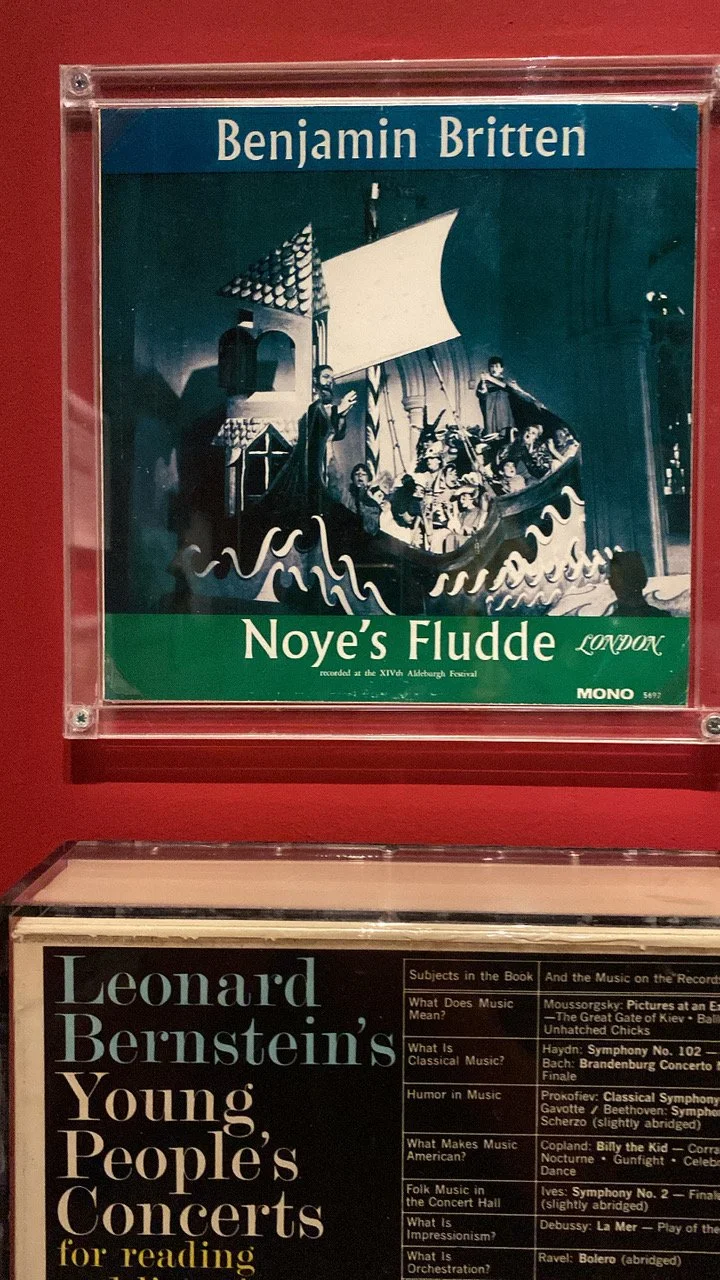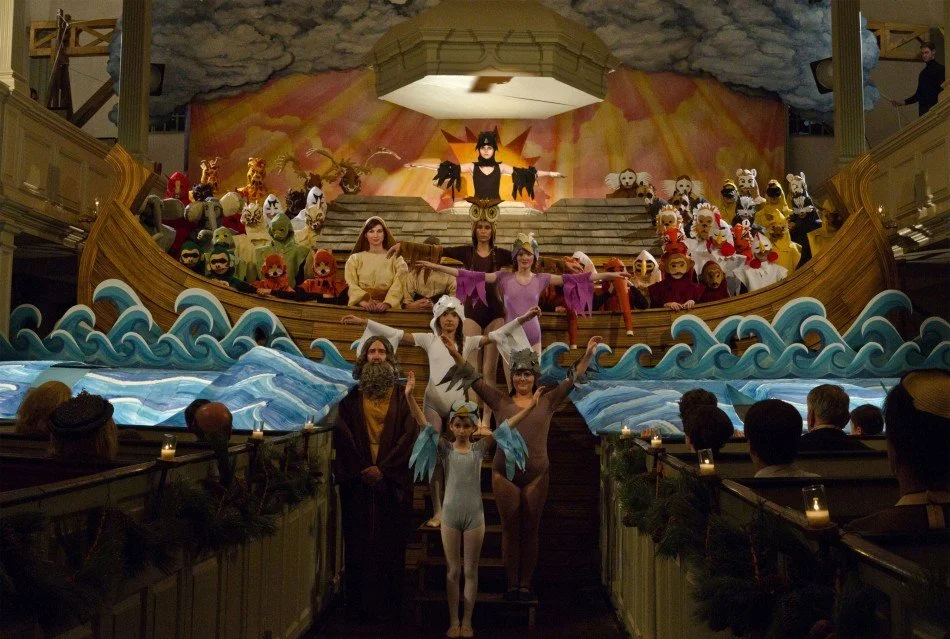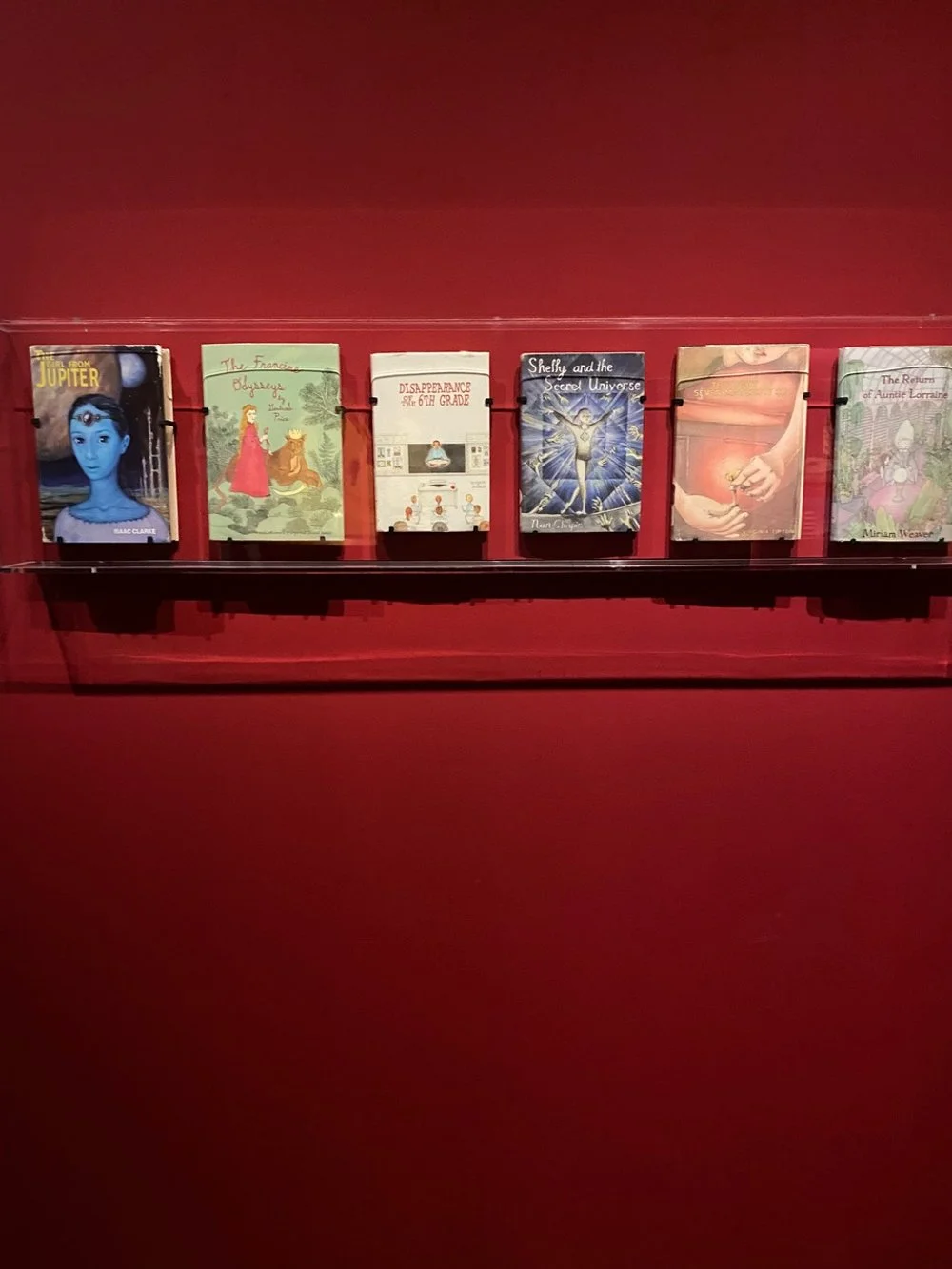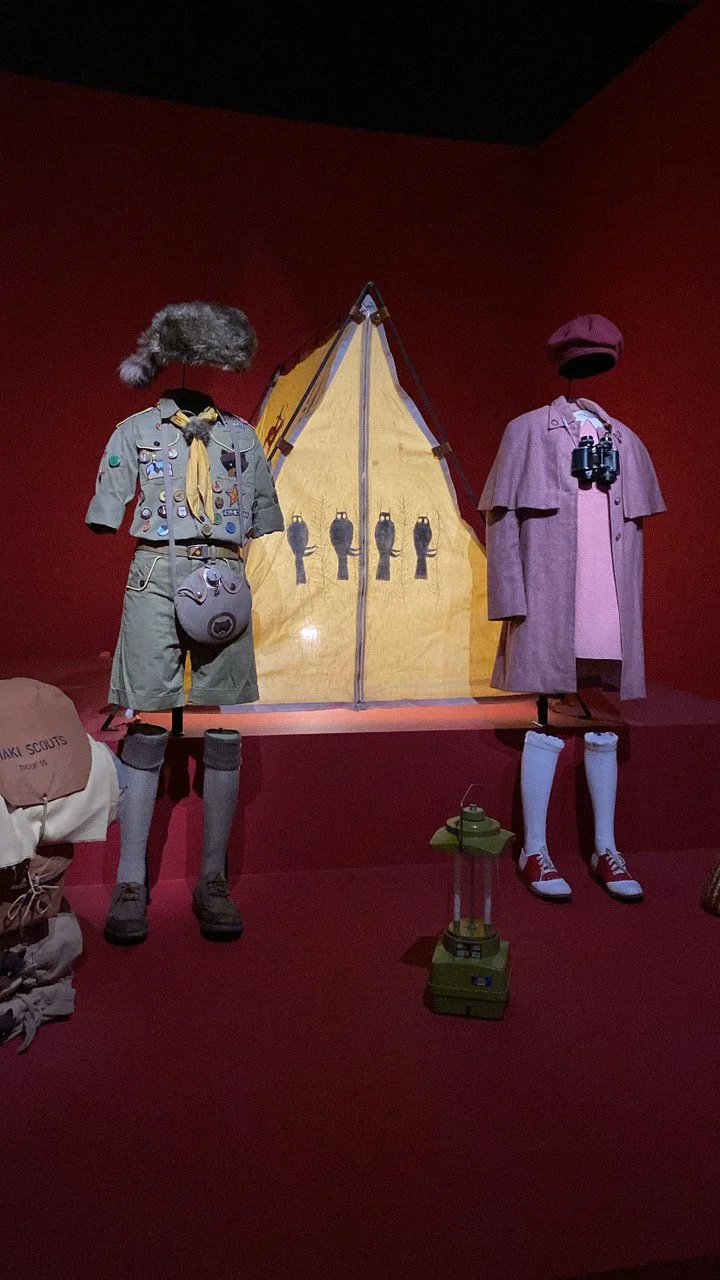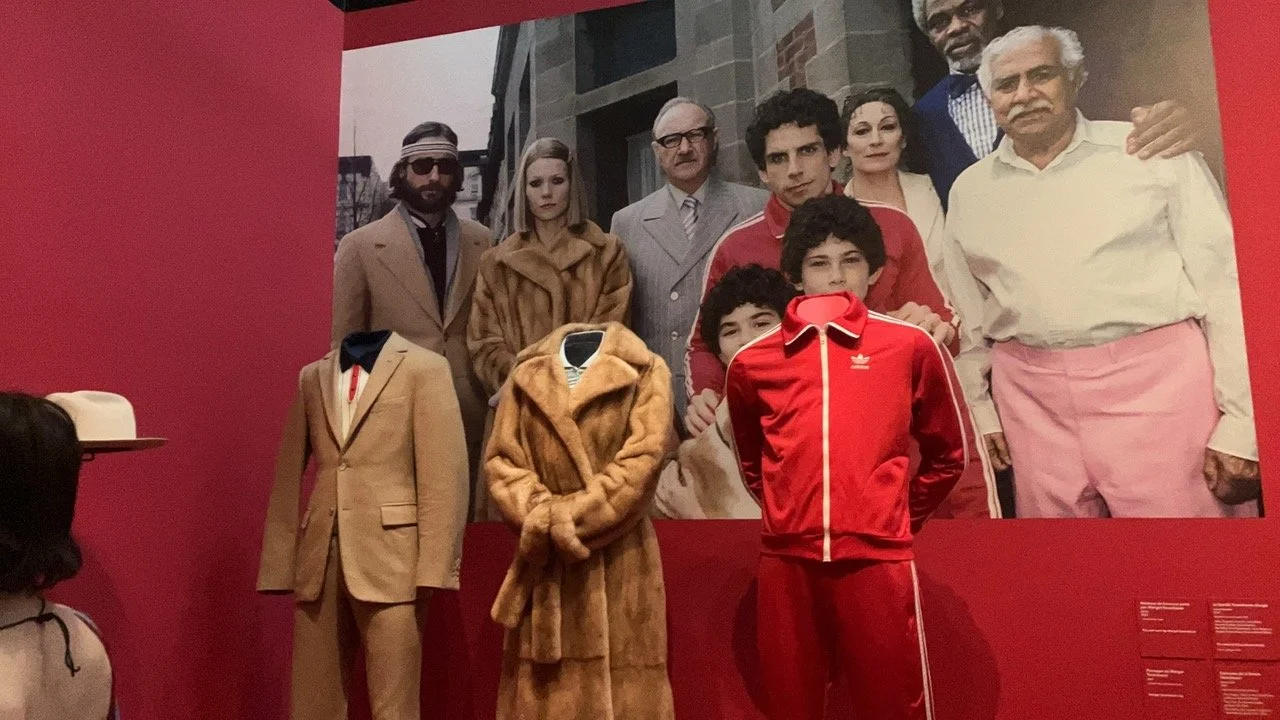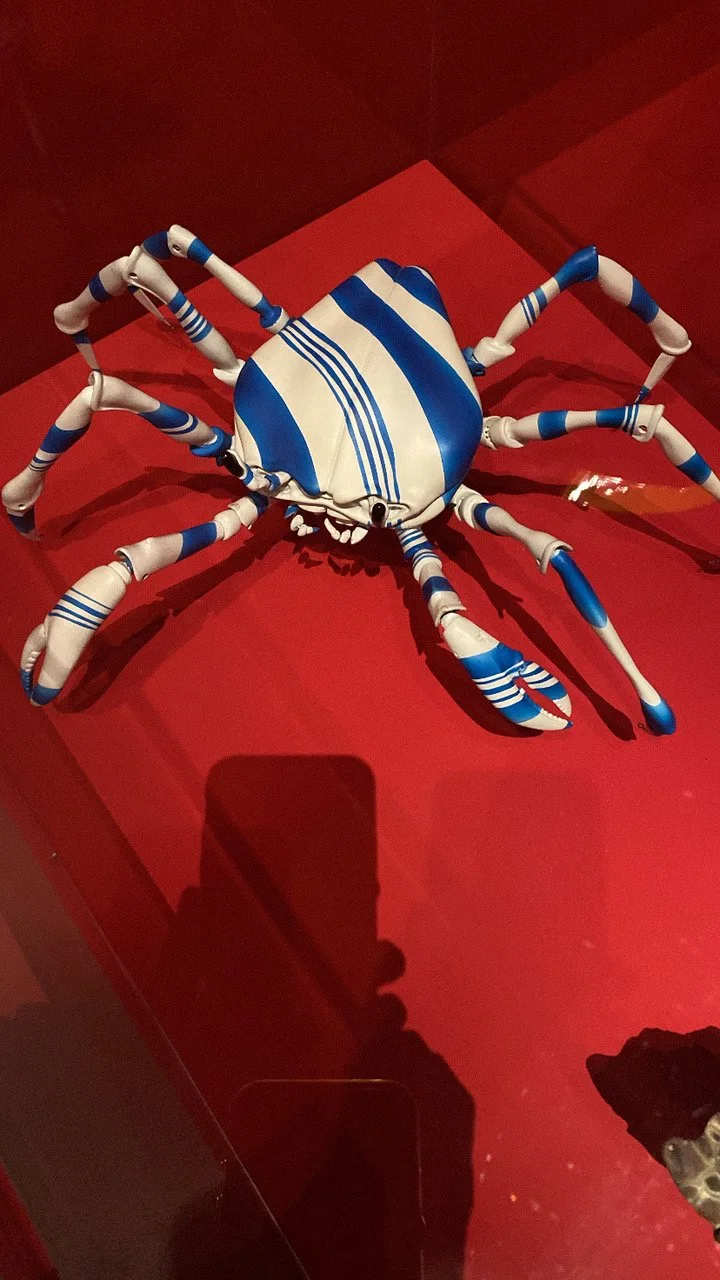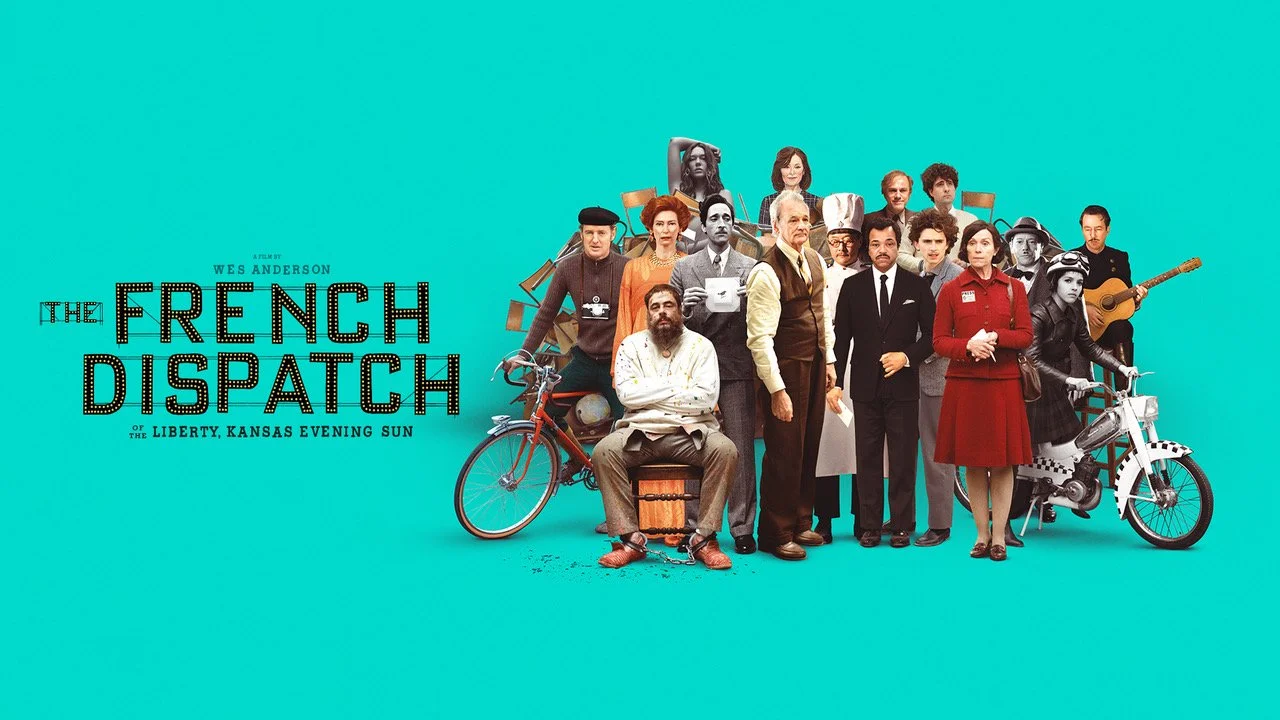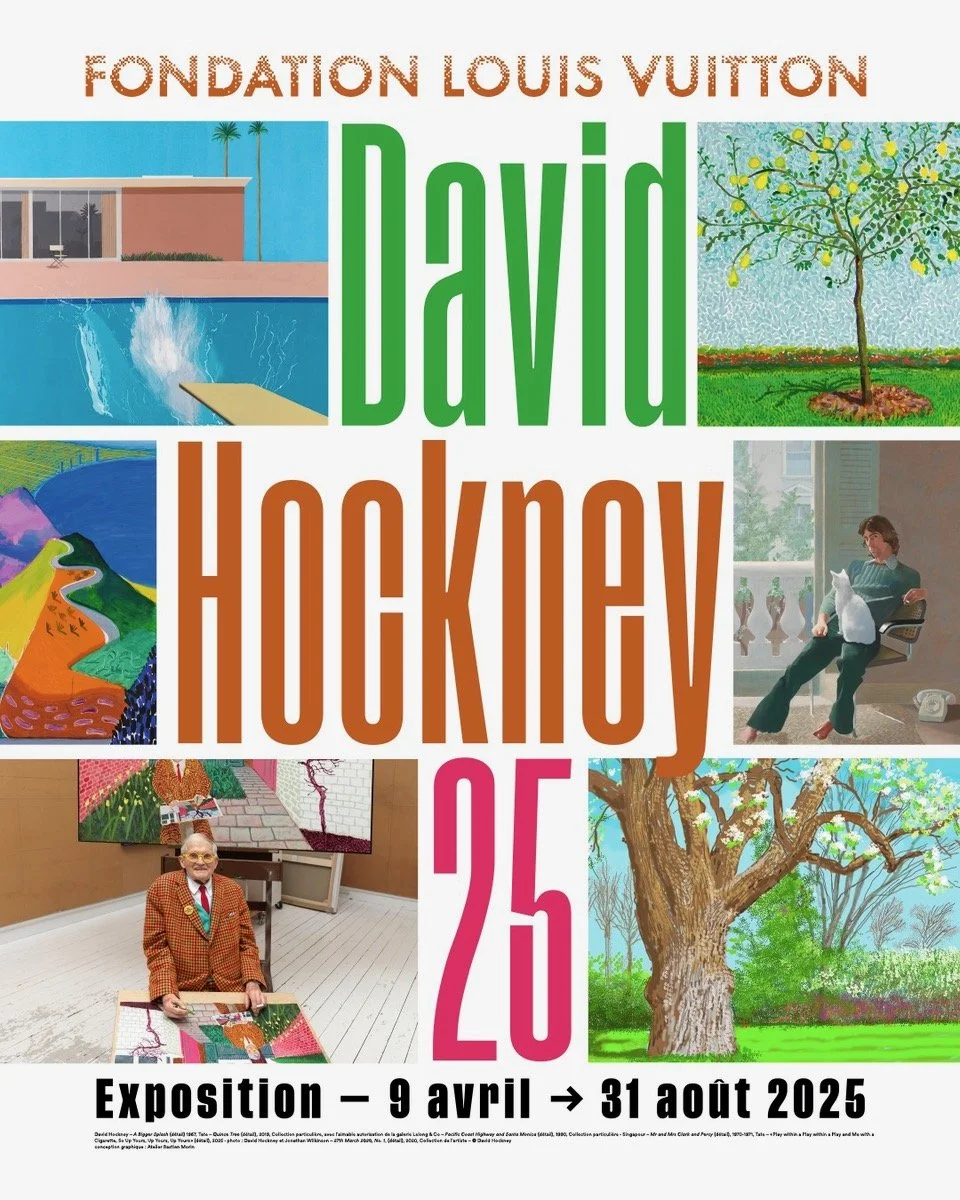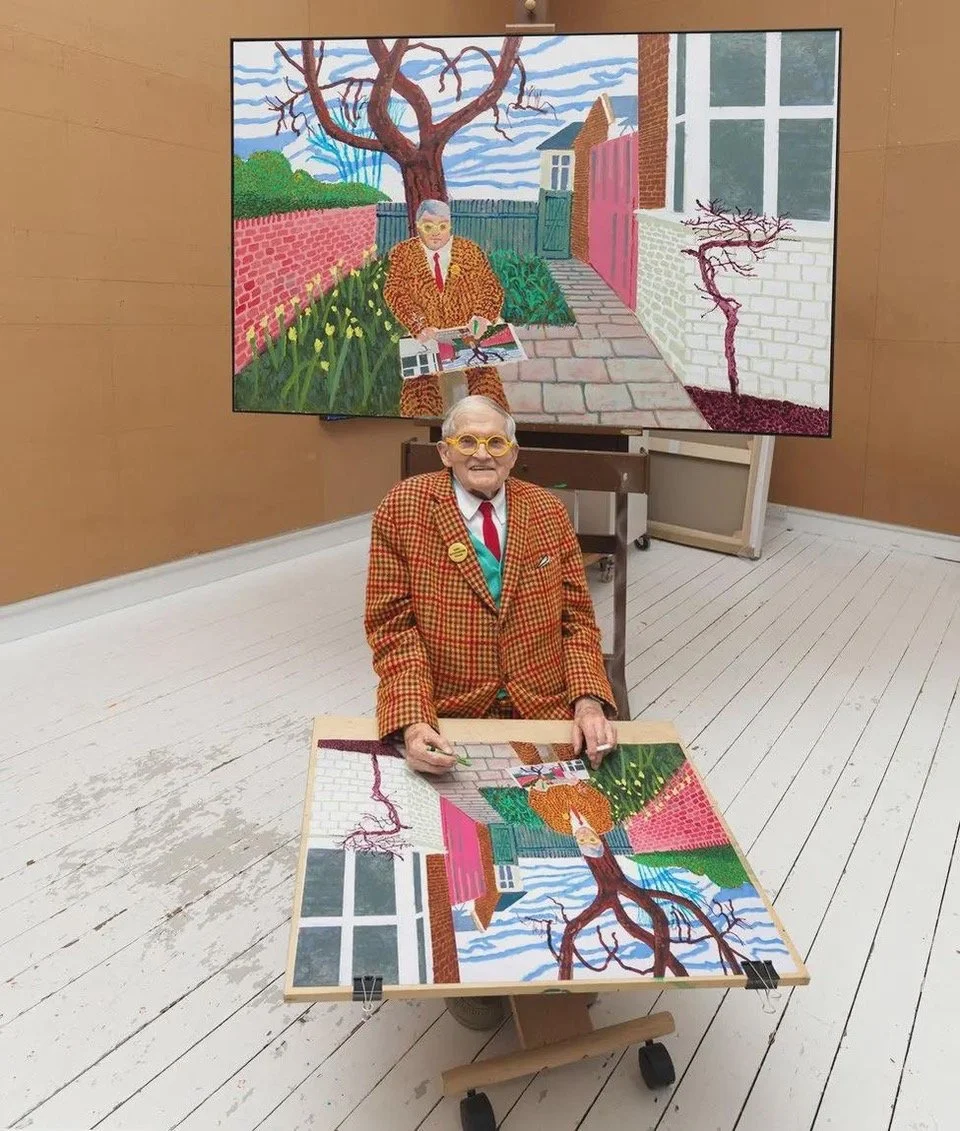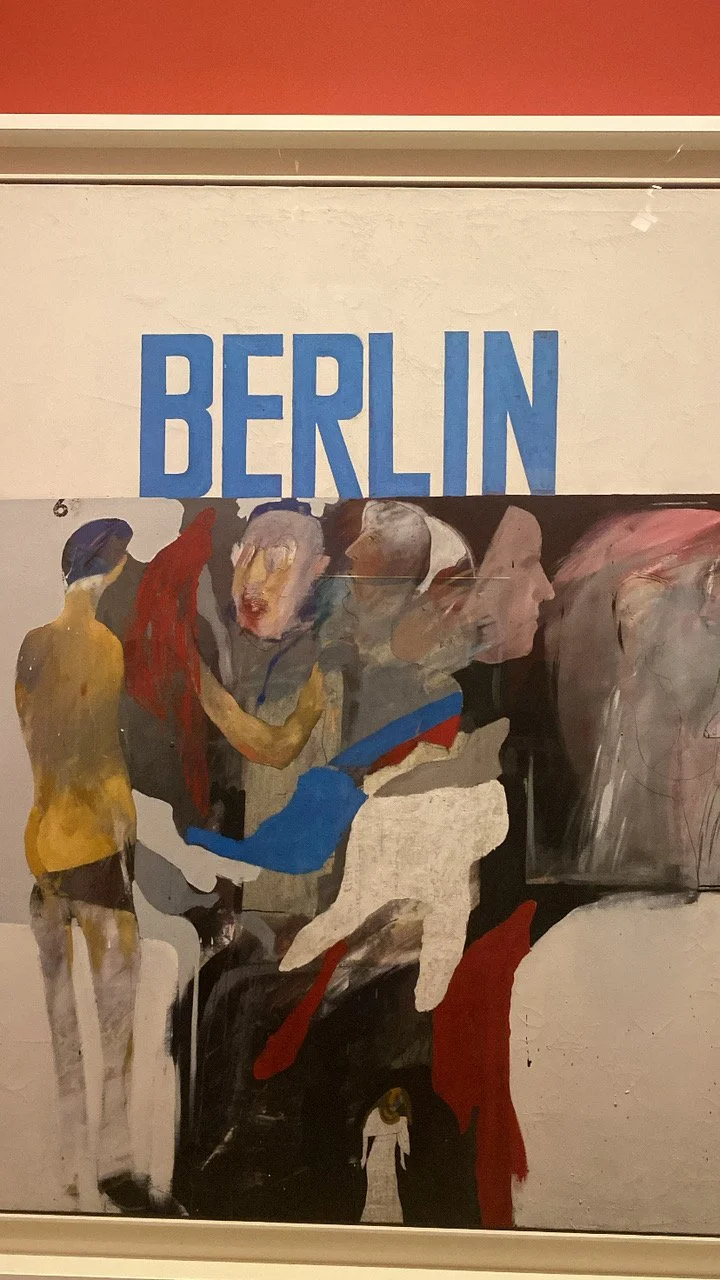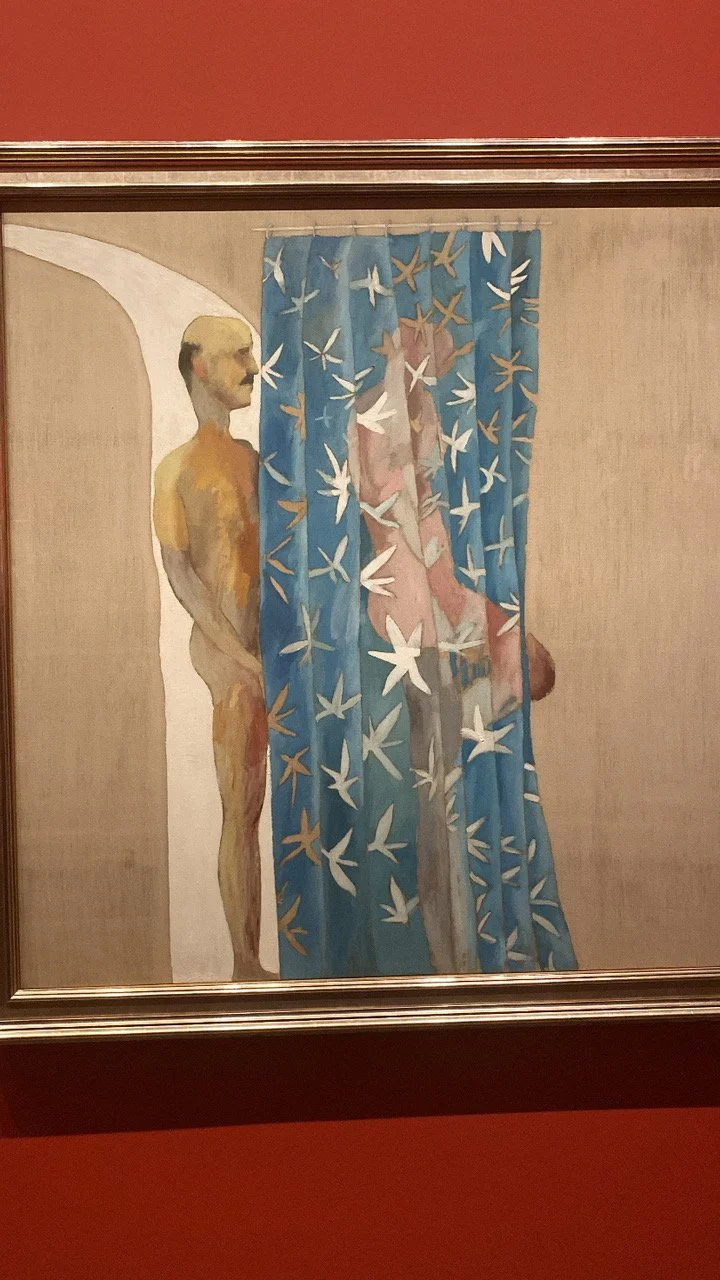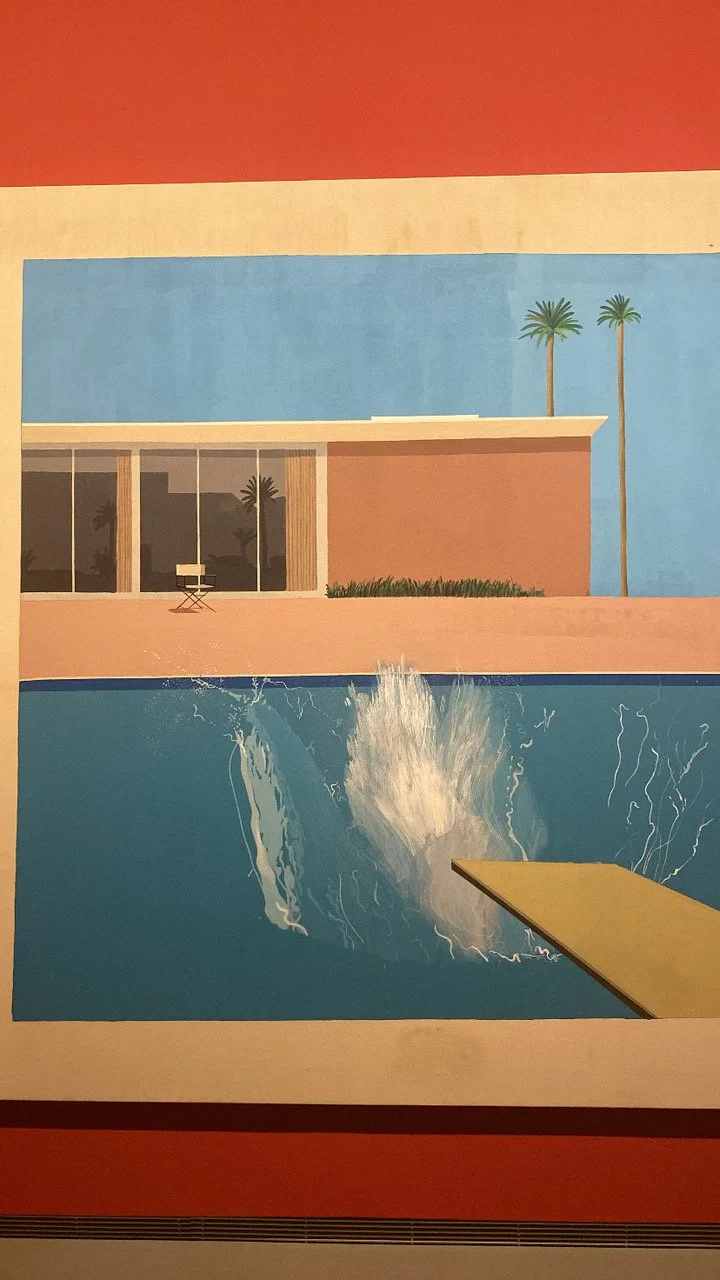A lot of Anderson and a little bit of Hockney
Accidentally Wes Anderson
Bienvenue and welcome back to Musée Musings, your idiosyncratic guide to Paris and art. Since Nicolas and I have been back in Paris, the city has been see-sawing between heat waves and torrential downpours. We look forward to the downpours, anticipating a respite from the heat. Alas, the downpours are occasionally accompanied by tennis ball (not golfball) size hail and the respites have been disappointingly brief.
It’s been difficult to plan outings in this weather - either too hot or two wet. I’ve been reduced to going to one museum a week for the last two - definitely not as satisfying as my Berlin binges. (Figs 1, 2) Last week, we went to La Cinémathèque française and this week we were at the Fondation Louis Vuitton.
Figure 1. Nicolas surveying his handiwork, Berlin
Figure 2. Top center - a shout out to Bev, replacing the shout to mom of earlier years!
Here’s a trick question - what do the two exhibitions have in common? Answer: both are being held in buildings designed by Frank Gehry. (Figs 3, 4)
Figure 3. Cinematheque, Paris (originally American Center) designed by Frank Gehry, 1993
Figure 4. Fondation Louis Vuitton, Paris designed by Frank Gehry, 2006 (opened 2014)
it was my first visit to La Cinémathèque française. We were there for an exhibition about the filmmaker, Wes Anderson. (Fig 5) His films are ones I find easy to watch because the violence is rare and the stabbings and maimings are usually accompanied by slapstick comedy or lighthearted animation or both. Anderson’s attention to detail, actually obsession, was demonstrated time and again in this exhibition of costumes and clips, props and posters. His obsession with detail means that the more attention you pay, the more you’re likely to appreciate his films. And you can watch them over and over.
Figure 5. Wes Anderson Exposition, Cinémathèque, Paris, March-July, 2025
One of my favorite Wes Anderson films is The Grand Budapest Hotel. (Fig 6) When the film begins, the year is 1985. A writer explains how he happens upon his stories. No, he says, they do not spring solely from his imagination. When people learn that he is a writer, they share their stories with him. We are taken next to 1968 when the lone surviving protagonist of the story the writer has told, shares the details of his life with the writer. The real action unfolds in 1932. When the film came out in 2014, Obama was the President of the United States and images of soldiers stopping trains and passing from car to car demanding to see the occupants’ papers was a reminder of Europe’s unhappy past. (Fig 7) A past that was not remotely connected to my life in the United States.
Figure 6. Mock up of Grand Budapest Hotel facade
Figure 7. Soldiers preparing to stop train and check all passenger identity papers, Grand Budapest Hotel
When I watched the film again this week, what was happening on the screen was a chilling reminder of how quickly things can change and not just in countries with authoritarian pasts. At least the soldiers in the film wore uniforms so they could be identified as agents of the government. They weren’t walking around in packs, masked, in civilian clothes, harassing people and demanding to see their papers, sometimes detaining people even when those papers were produced.
The characters of the first period are Mr. Gustave, the concierge of the Grand Budapest Hotel, Zero, his loyal, undocumented lobby boy and Agatha, a young woman who works in a bakery and eventually becomes Zero’s wife. The lives of these three characters play out against the backdrop of an Eastern European country careening toward authoritarianism. At one point, the Grand Budapest Hotel is filled with banners emblazoned with ZZs, (Fig 8) a barely veiled reference to the SS banners that flew everywhere during the Third Reich. The protagonists are swept along by a series of dramatic, but essentially comedic misadventures centered on the disputed inheritance of a Renaissance painting. The story doesn’t have a happy ending, just a tidy one.
Figure 8. ZZs (rather than SSs) in lobby of Grand Budapest Hotel
There are hints of Alfred Hitchcock thrillers and whiffs of Tintin comic books. But the most important influence is confirmed at the end of the film, as the credits roll. “Inspired by the writings of Stefan Zweig, Born: Vienna, 1881. Died: Petropolis, 1942.
Have you heard of Stefan Zweig? He wrote biographies, among them, one about Marie Antoinette which he called, Marie Antoinette, Portrait of an Average Woman. (Fig 9) He’s mostly forgotten in the United States, but he was never forgotten in France. There’s a statue of him in the Luxembourg Gardens that looks a lot like the statue of the author to which a young girl pays homage in the opening scene of Anderson’s film. (Figs 10, 11) Born in 1881, Zweig was the second son of a wealthy industrialist, who because of birth order, wasn’t expected to go into his father’s business. Instead, he had the luxury of devoting his time to writing and lecturing. According to Matthew Anderson (BBC Culture, 3/2014) Zweig was the epitome of “the idea of European sophistication that vanished with the Nazis’ rise to power.” To Anderson, Wes Anderson’s enthusiasm for Zweig is evident in every frame of the film which is “a fantasia on themes from Zweig’s life and works, an homage to the writer and his refined vision of Europe before World War II.” He would have been a perfect model for Proust’s Swann.
Figure 9. Marie Antoinette. The portrait of an ordinary woman, Stefan Zweig, 1932
Figure 10. Portrait bust of Stefan Zweig, Luxembourg Garden, Paris
Figure 11. Girl paying homage to Author opening scene of Grand Budapest Hotel
Figure 11a. Me paying homage to statue of Zweig
Zweig wrote fiction, too. According to Oliver Matuschek, Zweig’s biographer, “The hotel is the best stage you could invent for a writer like Zweig. There are all sorts of people there, from very grand guests to humble members of staff.” For Matuschek, two of Zweig’s books of fiction stand out as sources of Anderson’s inspiration, The Post-Office Girl, about a poor female postal clerk whose rich cousin from America invites her to join them at a posh Swiss resort. All does not go well, class is like that. And 24 Hours in the Life of a Woman, which includes a luxury hotel, a scandal and is “narrated as a story within a story, one of Zweig’s favorite devices.”
Roberta Silman (April 2014) thinks Anderson was most influenced by Zweig’s memoir, The World of Yesterday, completed in 1942, before the full range of the Holocaust horrors were known. The world Zweig writes about was “a world whose eccentric values Anderson captures perfectly.” For Silman, Zweig’s memoir is an eloquent warning that change comes when you least expect it and all of our lives are entangled in world politics, whether we like it or not. When Hitler appears in his memoir, Zweig writes, “It is an iron law of history that those who will be caught up in the great movements determining the course of their own times always fail to recognize them in their early stages.”
Zweig left Germany in 1934, when his books were banned and his speaking engagements canceled. He fled first to London, then to New York and finally to Brazil, where in 1942, 8 years after he left his homeland, he and his wife committed suicide. His suicide note read, “The world of my own language sank and was lost to me and my spiritual homeland Europe destroyed itself.”
Silman expressed the hope in 2014, before the 100th anniversary of WWI and before anyone could imagine that Trump would have a first term, let alone a second one, that the world “would be inspired to (be) more affectionate, more tolerant, more reasonable.” Well 11 years later, I can assure Ms Silman that didn’t happen.
Most of Anderson’s films take place on a more intimate stage, a smaller canvas. Like one of my all-time favorites, The Darjeeling Limited (2007). It’s about three brothers who reconnect after their father’s death and take a road trip to India to find their mother and maybe themselves. (Fig 12) The film is an unexpected link to the Fondation Louis Vuitton. The brothers’ luggage, two pieces of which are in the exhibition, was manufactured by Louis Vuitton and decorated with motifs based on designs by Anderson’s brother. (Figs 13, 14) When the filming was over, the luggage was auctioned off and the proceeds went to UNICEF and a medical treatment charity in India.
Figure 12. Three brothers (Jason Schwartzman, Owen Wilson, Adrien Brody), Darjeeling Limited
Figure 13, Brothers walking across India with their bespoke luggage, Darjeeling Limited
Figure 14. Luggage from Darjeeling Limited at Wes Anderson Exhibition, Paris
We’re so used to product placement in films that we can be excused for assuming that the Louis Vuitton luggage was in the film for that reason. But it wasn’t. Marc Jacobs, who was the creative director of Louis Vuitton at the time, is a friend of Anderson. According to Hadley Freedman, (Guardian 2007) Jacobs provided the bags free of charge and, unless you study the credits, you wouldn't know for sure that the bags were made by Louis Vuitton because, instead of the LV monogram, Wes Anderson's brother created a whimsical design for where the logo usually goes. The role of the luggage in the film wasn’t a minor one. It was every bit as important as the brothers themselves. Their bespoke luggage was, according to James Cavender, a metaphor for the emotional baggage the brothers carried around with them after their father’s death.
But that was then and this is now. Thanks to Louis Vuitton’s new menswear creative director, Pharrell Williams, the luggage is back. The press release for his 2026 Spring Menswear Collection states that the animal motif originally created for Wes Anderson’s film The Darjeeling Limited has been revisited for the first time. Palm trees, cheetahs and zebras are hand-embroidered on a range of pieces from cashmere coats and denim sets to bags and suitcases. (Figs 15, 16) And the Louis Vuitton logo is where it belongs, replacing The Darjeeling Limited characters of the original design.
Figure 15. Animal motifs from Darjeeling Limited on coat, L-V Spring 2026 Fashion Show
Figure 16. Animal motifs from Darjeeling Limited on bag, LV Spring 2026 Fashion Show
Moonrise Kingdom is another of Anderson’s intimate stories. Two odd kids, Suzy and Sam, find one another backstage at a church-hall performance of Benjamin Britten’s Noye’s Fludde, Noah’s Flood. Britten’s opera, based on a medieval mystery play was written to be performed by children and adults; amateurs and professionals with scenery and costumes and props meant to be both homemade and store bought. The opera gives the violent hurricane and flash floods that happen during the film its meteorological context. Apparently, Noye’s Fludde was an important childhood memory for Anderson, who explained it this way at the Cannes Film Festival in 2012, “The Britten music had a huge effect on the whole movie. That music is something I’ve always remembered, it made a very strong impression on me. It’s the color of the movie in a way.”
There are so many odd and endearing tidbits, like when Sam and Suzy decide to run away, Sam brings camping equipment and Suzy brings her kitten and a pair of binoculars, a stack of books stolen from the library, a record player and a recording of Britten’s Young Person’s Guide to the Orchestra. (Figs 17-20) The hero of the film is the town’s compassionate police chief. Children’s Social Services is, as usual, the enemy.
Figure 17. The poster for Noye's Fludde & record Suzy brings with her, Britten’s Young People’s Concert for Moonrise Kingdom
Figure 18. Noye’s Fludde performance, Moonrise Kingdom
Figure 19. Books Suzy brings with her to run away with Sam, Moonrise Kingdom
Figure 20. Sam's and Suzy’s outfits when they run away, Moonrise Kingdom
Since seeing the exhibition, I have also watched The Royal Tenenbaums, The Life Aquatic and French Dispatch again. (Figs 21 - 23) My appreciation for all of them improved with a second watching. Not as much as I hoped for with French Dispatch which I wanted so much to love, it being about France and The New Yorker and all. If you are here in Paris, definitely try to see the exhibition and then rewatch some Anderson films. And maybe check out Anderson’s newest offering, The Phoenician Scheme.
Figure 21. Cast and costumes, Royal Tenenbaums
Figure 22. Crab from The Life Aquatic
Figure 23. Cast of characters in French Dispatch
Now, onto David Hockney. I finally saw the Hockney exhibition at the Fondation Louis Vuitton.(Fig 24) I should have seen it sooner. It is the perfect antidote to the prescient Degenerate Art exhibition at the Musée Picasso that I wrote about for nearly a month and that I can’t stop thinking about as the parallels keep mounting, Books banned and then burned. Art exhibitions defunded and canceled because they smack of diversity. Art reclassified as degenerate. Rights being trampled upon by an authoritarian regime run by corrupt power hungry leaders and the oligarchs who fund them. Oligarchs, if Russia offers any clues, who can be jailed and eliminated by those leaders with impunity. So I’m not really sure what is going to happen to the former BFF now that the dear leader’s Big Beautiful Bill has passed into law. He’s threatening to start a third party. He pissed off most of the demographic who used to buy his electric cars with his Nazi salutes and DOGE abuses. And now he’s pissing off the thugs who used to be in thrall of him.
Figure 24. David Hockney 25, Fondation Louis Vuitton April - August 2025, poster
As I said, David Hockney is the perfect antidote. At the entrance to the Fondation Louis Vuitton is a pink neon sign that reads, “Do remember they can’t cancel the spring,” (Fig 25) That’s what he wrote to friends and family during the Covid lockdown. When he sent them sketches of spring in Normandy that he made on his iPad. He wear a button that reads, “End Bossiness Soon.” (Figs 26, 27) It originally read, “End Bossiness Now” but he decided against it because, well, because it’s too bossy.
Figure 25. In pink neon on Fondation Louis Vuitton, Do remember they can’t cancel the spring
Figure 26. David Hockney with a painting of himself painting a self portrait wearing Bossiness button
Figure 27. End Bossiness Soon button worn by Hockney and all his friends
The exhibition is called David Hockney 25. The focus is Hockney’s works of the past 25 years, the 21st century. The works he created - on canvases with paint and brushes, on I-pads with his finger as his paint brush, with still cameras and polaroids and video cameras. All created from age of 62 to age 87. He will be 88 in a few days (July 9). He’s not sure he’ll live that long. He wasn’t sure, nobody was, that he would make it to the opening of this, the largest of all his retrospectives. He’s been ill for the past 2 years. It’s why he left Normandy and moved back home, to London. He has 2 full time nurses, both of whose portraits are on the wall of portraits of people who are close to him - his sister and brother and great nephew and …. Harry Styles!! (Fig 28 - which I saw a few months ago at the National Portrait Gallery, London).
Figure 28. Photo of David Hockney painting Harry Styles’ portrait (portrait is in exhibition & at National Gallery)
The exhibition includes works by Hockney that were painted well before 2000, but before I tell you about them, here’s how Jackie Wullschläger began her review of the exhibition (Financial Times, April 8, 2025) “It is a country for old men, (a reference to the film, No Country for Old Men) the president (of the Fondation Louis Vuitton) Bernard Arnault, 76, invited Hockney, 87, to fill the… museum designed by his friend Frank Gehry, 96, (for an exhibition) curated by another friend, Norman Rosenthal, 80.”
The exhibition starts with paintings which you probably would not recognize as Hockney’s and others which refer to homosexuality, years before English laws about homosexuality were finally changed. (Figs 29, 30) Which was very brave of him in that those were the laws that sent Oscar Wilde to prison and the code breaker of WWII, Alan Turing, to commit suicide at age 41.
Figure 29. Berlin, David Hockney
Figure 30. Two men in a shower, David Hockney
Some of his most iconic paintings are here, like the swimming pools in L.A. (Fig 31) and the Grand Canyon and the paintings and videos he made in England when he finally got back to a place with seasons. And there are his paintings of Normandy with which I have been in love since I first saw them. On the top floors, when you think that this meal simply cannot get any richer, there’s a room celebrating dance, with space for you to join in. And an immersive space where you can plop down on a bean bag and become as one with Hockney’s stage set designs. There’s so much to tell you and I will next week. In the meantime, if you are here in Paris you must see this exhibition. Gros bisous, Dr. B.
Figure 31. A bigger splash, David Hockney
New comment on Berlin Beckoned, II:
Dr. B. Please keep up the comparisons between what you are viewing and perceiving and what is happening here in the US. it is so important to offer this! Here we are having friends carry papers to prove they are citizens if they are the 'wrong color' lately as they go about their lives in the US. Fear of unmarked cars, masked and weaponed thugs in the streets who are ICE, chases in fields and factories, incarceration of women and children is not ending despite weak complaints and pleas by officials who are helpless in the onslaught of the current lawless 'government'. Can the US survive this or will the picture darken more to total authoritarianism here? Dianne
Hi Beverly, Hello. Yes, I read your article, and I thought it was spot on. I thought you might get some blow back. I remember you had it before when you expressed your opinion about what is going on here in America. It is truly disgusting and scary here. The Clerk in the House is right now reading aloud the over 900 page “ Beautiful Big Bill” which will cut parts of Medicare and SNAP, but will give tax breaks to his cronies.
My late husband and I lived inI Worms , Germany for a while in the 60s when the WALL was still up. We lived on the top floor of someone’s house and even though we had our own bathroom ( a big plus in those days) we had no hot running water! Every time I heard a police car with that sound from the movies I felt like I should hide. We went to Berlin and you would have thought the war had just ended in East Berlin. Not much had been fixed up. I had gone there years later and the joke was that it was the city of cranes, meaning construction cranes. Deedee, Baltimore
Why don't you post your replies to comments? I'd love to read them, and I'm confident other readers would too. Morris
Hi Morris, I decided to stop writing public responses to Comments for two reason. The first reason is because this website does not automatically send my responses to people’s comments to the people who commented. The second reason is that I have found that responding privately permits a more open dialogue since it is only between me and the Commenter. And the conversation often continues. Beverly
